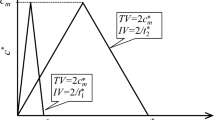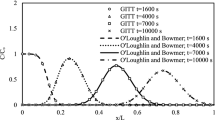Abstract
A numerical model to simulate the accidental pollutant transport in rivers was developed using the two-dimensional finite element method. RAM4 is developed as the scalar transport module of the software RAMS (River Analysis and Modeling System) which can provide a graphical user interface for various river topographies and has recently been released as a beta version. The significance of RAM4 is that it is able to treat the pollutant mass itself, which is instantaneously released at a certain point of a river. The development of this ability was motivated by the inadequacy of the previous method, whereby the instantaneous mass release was expressed by defining some initial concentration at a source point. This method is not able to balance the injected mass value in accordance with the numerical time step size and the magnitude of flow velocity at this point. RAM4 was connected with the RAMS graphic user interface so that the source point and the released mass value can be controlled with a user-friendly graphical tool. The hydrodynamic module of RAMS, named RAM2, is currently undergoing beta-testing. Therefore, RAM4 was applied to the real river using the popular hydrodynamic model, RMA2, in TABS-MD. Using the obtained flow field computed by RMA2, the model has been simulated for a number of example scenarios of mass dumping accidents in the Han River of Korea in order to verify the applicability of this method in a real situation.
Similar content being viewed by others
References
Alavian, V. (1986). “Dispersion tensor in rotating flows.” J. Hydr. Engrg., ASCE, Vol. 112, No. 8, pp. 771–777.
Basha, H. A. (1997). “Analytical model of two-dimensional dispersion in laterally nonuniform axial velocity distributions.” J. Hydr. Engrg., ASCE, Vol. 123, No. 10, pp. 853–862.
Bellasio, R. and Bianconi, R. (2005). “On line simulation system for industrial accidents.” Environ. Model. Software, Vol. 20, No. 3, pp. 329–342.
Bianconi, R. and Tamponi, M. (1993). “A mathematical model of diffusion from a steady source of short duration in a finite mixing layer.” Atmospheric Environ., Vol. 27A, No. 5, pp. 781–792.
Brooks, A. N. and Hughes, T. J. R. (1982). “Streamline upwind/Petrov-Galerkin formulations for convection dominated flows with particular emphasis on the incompressible Navier-Stokes equations.” Comp. Meth. Appl. Mech. Eng., Vol. 32, No. 1–3, pp. 199–259.
EMRL (2003). Surface-water modeling system: Tutorials Version 8.1, Brigham Young University.
Fischer, H. B., List, E. J., Koh, R. C. Y., Imberger J., and Brooks N. H. (1979). Mixing in inland and coastal waters, Academic Press, Inc.
Irons, B. M. (1970). “A frontal solution program.” Int. J. Num. Meth. Eng., Vol. 2, pp. 5–32.
King, I., Donnell, B. P., Letter, J. V., McAnally, W. H., Thomas, W. A., and LaHatte, C. (2006). RMA2 users guide 4.5x, US Army, Engineer Research and Development Center, WES, CHL.
King, I., Letter, J. V., and Donnell, B. P. (2005). RMA4 users guide 4.5x, US Army, Engineer Research and Development Center, WES, CHL.
Lee, M. E. and Seo, I. W. (2007). “Analysis of pollutant transport in the Han River with tidal current using a 2D finite element model.” J. Hydro-env. Res., IAHR, Asia-Pacific Div., Vol. 1, No. 1, pp. 30–42.
Piasecki, M. and Katopodes, N. D. (1997). “Control of contaminant release in rivers. I: Adjoint sensitivity analysis.” J. Hydr. Engrg., ASCE, Vol. 123, No. 6, pp. 486–492.
Piasecki, M. and Katopodes, N. D. (1997). “Control of contaminant release in rivers. II: Optimal design.” J. Hydr. Engrg., ASCE, Vol. 123, No. 6, pp. 493–503.
Raymond, W. H. and Garder, A. (1976). “Selective damping in a Galerkin method for solving wave problems with variable grids.” Monthly Weather Rev., Vol. 104, pp. 1585–1590.
Seo, I. W., Lee, M. E., and Baek, K. O. (2008). “2D Modeling of heterogeneous dispersion in meandering channels.” J. Hydr. Engrg., ASCE, Vol. 134, No. 2, pp. 196–204.
Tixier, J., Dusserre, G., Rault-Doumax, S., Ollivier, J., and Bourely, C. (2002). “ORISIS software for the consequence evaluation of transportation of dangerous goods accidents.” Environ. Model. Software, Vol. 17, pp. 627–637.
Yu, T. S. and Li, C. W. (1998). “Instantaneous discharge of buoyant fluid in cross-flow.” J. Hydr. Engrg., ASCE, Vol. 124, No. 1, pp. 1161-1176.
Yu, F. X. and Singh, V. P. (1995). “Improved finite-element method for solute transport.” J. Hydr. Engrg., ASCE, Vol. 121, No. 2, pp. 145–158.
RAMS homepage (2009). www.RAMS.or.kr.
Author information
Authors and Affiliations
Corresponding author
Rights and permissions
About this article
Cite this article
Lee, M.E., Seo, I.W. 2D finite element pollutant transport model for accidental mass release in rivers. KSCE J Civ Eng 14, 77–86 (2010). https://doi.org/10.1007/s12205-010-0077-9
Received:
Accepted:
Published:
Issue Date:
DOI: https://doi.org/10.1007/s12205-010-0077-9




